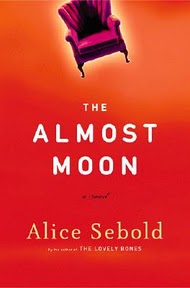 The Almost Moon–Alice Sebold–2007-Little Brown-IP
The Almost Moon–Alice Sebold–2007-Little Brown-IP
One may have assumed that if I were to choose something from this author to be on my best list, it would be her major seller, The Lovely Bones. Made into a film, and heralded by one and all, it would seem to be a natural fit. And the book was quite compelling. Original, if that’s possible in this day and age. Not exactly pure crime fiction, certainly not a mystery, The Lovely Bones is still considered crime fiction. If there is crime in a novel–crime fiction.
The Almost Moon, has stuck with me months after closing the book, and for that alone, it deserved consideration on the list. At first, after finishing the book, I wasn’t sure how I felt about it. It is a rather harrowing read, in that it brings unpleasant subjects to the fore, and examines them under great bright scrutiny. It too isn’t the typical crime novel–it really has little to do with the murder. We know who did it from the first sentence:
“When all is said and done, killing my mother came easily.”
The narrator is Helen Knightly. She has spent her life trying to find love from her mother, where none existed. Her mother, Clair, once a beauty, at age 50 hung cloths over all the mirrors. Although she’d only modeled slips and girdles in ads for stores like Wanamakers, Philadelphia’s major department store years ago, she considered herself cheated out of a great career by marrying an ordinary working man who brought her to a little town near Philly, Phoenixville. For this, she never forgave him, and her discontent increased her bitterness as time marched on.
“It was my mother’s disappointments that were enumerated in our household and that I saw before me every day as if they were posted on our fridge—a static list that my presence could not assuage.”
She became violent, throwing objects at her husband as he ducked and weaved, gracefully it seemed to his daughter, Helen. Helen worshiped her father who spent hours doing woodworking, when he wasn’t doing the house work or cooking. Things Clair should have taken care of, but didn’t. Clair progressively did less and less, eating little, never leaving the house, hysterical when her husband and daughter did. The severity of her self absorption came to a crisis when a little boy down the street was hit by a car in front of Clair’s house, and she did nothing to help him, other than to go to his side and stare. The neighborhood was enraged, and violence was in the air. Helen, a youngster herself, had to become the adult in the situation, her father earlier ‘injured’ himself in his work shed, and was away for months in the hospital.
Once, when father and daughter were alone, Helen asked
“Mom’s different, right?”
“I’d like to think that your mother is almost whole.” he said” “So much is about almosts, not quites.”
“Like the moon,” I said.
There it hung, a thin slice still low in the sky.
“Right,” he said. “The moon is whole all the time, but we can’t always see it, What we see is an almost moon, or a not-quite moon. The rest is hiding just out of view. But there’s only one moon so we follow it in the sky, we plan our lives based on its rhythms and tides.”
“Right.”
I knew I was supposed to understand something from my father’s explanation, but what I came away with was that, just as we are stuck with the moon, so too are we stuck with my mother. Wherever I’d travel there she’d be.”
Helen, now with grown daughters of her own, divorced, has been obligated in trying to help care for her aging mother, a task made much more difficult by her mother’s condition.
“Dementia, as it descends, has a way of revealing the core of the person affected by it. My mother’s core was rotten like the brackish water at the bottom of a weeks-old vase of flowers. ”
Alice Sebold knows how to elicit deep emotions from her characters and her readers. Her mother/daughter dynamic, struggles can be understood by any of us who have dealt with something similar, though probably not leading to murder. Helen’s situation is complex, her actions although not celebrated, have reasons. There is a suspense and pace to the narrative, and it engrosses the reader fully.
Although not traditional in any sense, The Almost Moon is certainly fiction with a crime, although which crime, the death or the way this family lived, is debatable.
Footnote: Just for the heck of it, I checked reviews of the book after finishing my article–and it makes me glad I didn’t do it before writing it–because some critics trounced it. Claiming the characters aren’t likable, the subject too dark and gritty, and the plot implausible. My impression of these criticisms is that The Lovely Bones was such a different book that this second piece of fiction startled and confused those who wanted a light at the end of the tunnel like experience they received with Bones. I don’t see all the characters as unlikable, actually, I felt very badly for Helen, and occasionally for Clair–mental illness or not, she was impossible to deal with, and cause for much misery in her family’s lives. At any rate, as I stated in the beginning, it’s my list, and I’ll choose what I want to, lol. Sort of like the song–“it’s my party and I’ll cry if I want to!”
PSSS. My father grew up around Phoenixville PA, and that also made for a more interesting read.
Don’t forget to check out the Best 100 Mysteries of All Time list!
